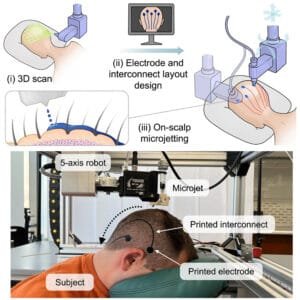Imagine replacing the cumbersome, time-consuming process of traditional electroencephalography (EEG) with a fast, painless, and efficient method. For the first time, scientists have developed a groundbreaking liquid ink that doctors can print directly onto a patient’s scalp to measure brain activity. Potentially, it can enhance non-invasive brain-computer interface applications.
The innovation of liquid ink introduces an electronic tattoo otherwise referred to as e-tattoo, created using a conductive polymer ink that flows seamlessly through hair and adheres to the scalp. Once dried, the thin-film sensor accurately detects brain activity through the scalp. This advancement not only simplifies the process of diagnosing neurological conditions like epilepsy and brain injuries but also holds enormous potential for expanding non-invasive brain-computer interface (BCI) applications. This innovation was published in the Cell Press journal Cell Biomaterials and marks a significant leap in neurological diagnostics and BCI technology.
“Our innovations in sensor design, biocompatible ink, and high-speed printing pave the way for future on-body manufacturing of electronic tattoo sensors, with broad applications both within and beyond clinical settings,” says Nanshu Lu, co-corresponding author at the University of Texas at Austin.
The Problem with Traditional EEG
EEG is a vital diagnostic tool for neurological conditions, including seizures, brain tumors, and brain injuries. However, the conventional setup involves a lengthy and uncomfortable process. Technicians must mark the patient’s scalp with rulers and pencils, glue electrodes to over a dozen spots, and connect them via long wires to a data collection machine and monitor the patient’s brain activity.
This setup is cumbersome and often uncomfortable for many patients, who must remain seated for hours during the test. Additionally, the electrodes’ gel dries out after a few hours, reducing signal quality.
The Rise of E-Tattoos
Over the past few years, Lu and her team have been at the forefront of e-tattoo technology, creating small sensors to track bodily signals from the surface of our skin. These sensors have been applied to the chest for heart activity, muscles for fatigue analysis, and even underarms to measure sweat composition.
However, printing these e-tattoos on hairy areas like the scalp posed a significant challenge. Traditional e-tattoos required adhesive material for transfer, which was ineffective on hairy skin. To overcome this, the researchers developed a unique liquid ink made from conductive polymers.
A Breakthrough Innovation
The team’s conductive liquid ink flows through the hair to reach the scalp, forming a thin-film sensor upon drying. The researchers use a computer algorithm to map the electrode spots on the scalp and a digitally controlled inkjet printer to spray the ink.
This revolutionary process is fast, contact-free, and entirely painless for patients. When tested on 5 participants with short hair, the printed e-tattoos delivered results comparable to conventional EEG electrodes while maintaining stable connectivity for over 24 hours far exceeding the performance of traditional electrodes, which began failing after just six hours.

In addition to stability, the team improved the ink’s formula to allow the e-tattoo to print conductive lines that replaced traditional wires. These printed lines prevent signal interference, further enhancing the accuracy of the EEG data.
“This tweak allowed the printed wires to conduct signals without picking up new signals along the way,” explains Ximin He, co-corresponding author at the University of California, Los Angeles.
A Wireless Future
The team also connected the printed e-tattoos to a small device using shorter wires to collect brainwave data. However, they aim to eliminate wires entirely by embedding wireless data transmitters into the e-tattoos.
“Our study can potentially revolutionize the way non-invasive brain-computer interface devices are designed,” says José Millán, co-corresponding author from the University of Texas at Austin.
Current BCI devices rely on large headsets that are often uncomfortable and unwieldy. By printing electronics directly onto the scalp, e-tattoos could replace these bulky systems, making BCI technology more accessible and user-friendly. Such devices can record brain activity linked to functions like speech or movement, enabling patients to control external devices without physical effort.
The Road Ahead
This cutting-edge technology is poised to transform neurological diagnostics and expand applications in brain-computer interface systems. Its promise of fast, painless application and stable connectivity opens doors to personalized healthcare and even wearable tech advancements.
As research progresses, the potential for e-tattoos to redefine healthcare and technology grows. Could this innovation shape the future of brain-computer interfaces?

